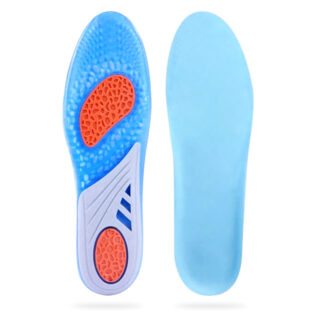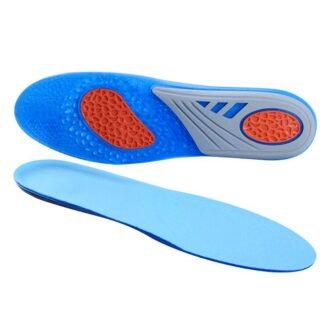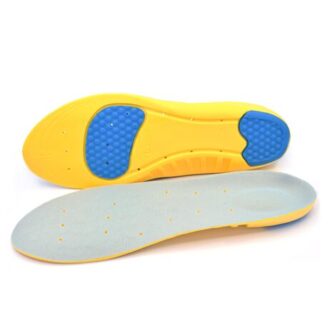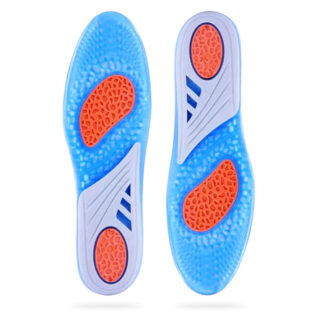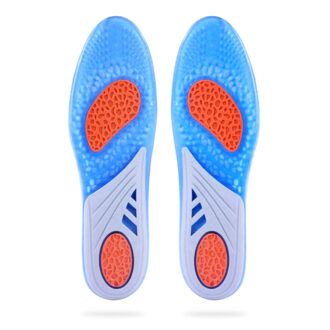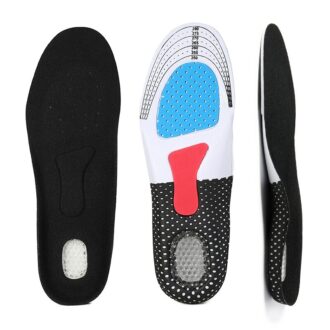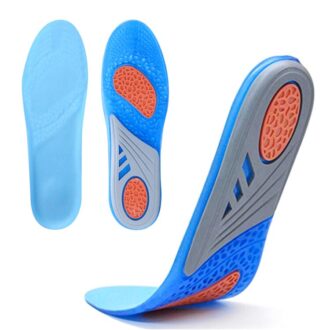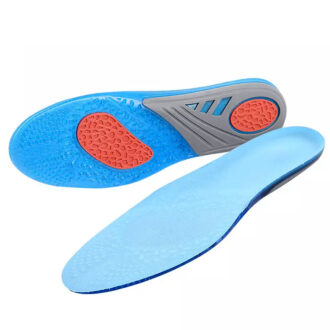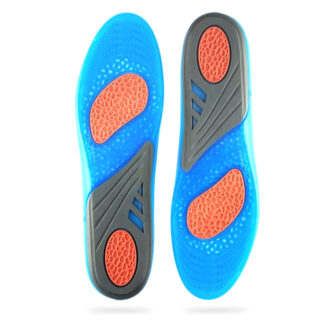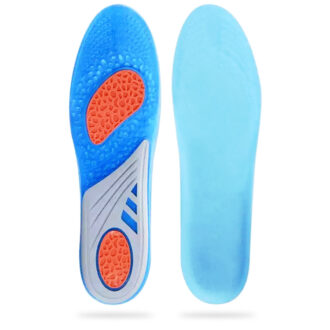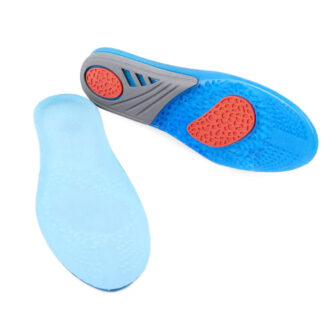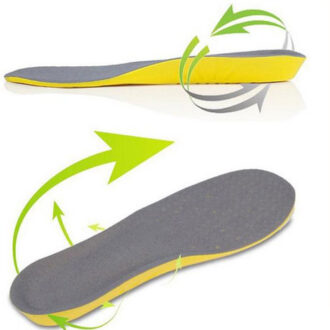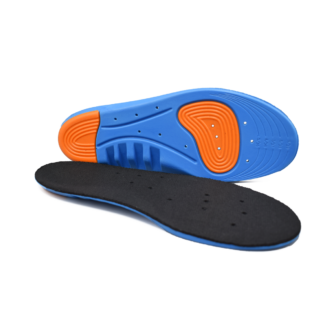No products in the cart.
Sports and Running Insoles
Discover the Difference: Elevate Your Performance with Nuovahealth Sports and Running Insoles
Are your feet, knees, hips, or back feeling the strain from your active lifestyle? Did you know that improper foot support can disrupt your entire kinetic chain (the sequence of movements your body goes through to perform an action), leading to a cascade of discomfort and injury? Whether you’re pounding the pavement or tearing up the court, the right insoles can be transformative.
The Problem: The Hidden Impact of Poor Foot Support
Engaging in sports and running without proper foot support can lead to a host of issues. From plantar fasciitis (inflammation of the band of tissue connecting your heel to your toes) to shin splints, and from knee pain to lower back discomfort, the repercussions are widespread. In the UK alone, over 200,000 running-related injuries are reported annually (source: British Journal of Sports Medicine). These injuries can severely limit your ability to stay active and enjoy your favorite activities.
When your feet are not adequately supported, each step reverberates through your body, placing undue stress on your ankles, knees, hips, and spine. This misalignment disrupts the kinetic chain, causing your body to compensate in ways that can lead to chronic pain and injuries.
The Solution: Nuovahealth Sports and Running Insoles
Enter our range of sports and running insoles at Nuovahealth – meticulously designed to provide the support your feet need, so you can perform at your best while protecting your entire kinetic chain. Our insoles offer advanced cushioning, superior arch support, and shock absorption to enhance your natural movement and reduce strain on your joints and muscles.
Why Choose Nuovahealth Insoles?
- Advanced Cushioning: Our insoles feature state-of-the-art foam that adapts to your foot’s contours, ensuring comfort and reducing impact.
- Superior Arch Support: With specially designed arches, our insoles help maintain proper foot alignment, preventing overpronation (excessive inward rolling of the foot) and supination (outward rolling of the foot).
- Enhanced Stability: The structured heel cups and supportive design stabilize your feet, reducing the risk of strain and injuries.
- Durability: Made with high-quality materials, our insoles are built to withstand the rigors of athletic activity.
The Benefits: Supporting Your Active Lifestyle
By investing in Nuovahealth sports and running insoles, you’re choosing to prioritize your health and performance. Our insoles can help you:
- Prevent Injuries: Reduce the risk of common injuries such as plantar fasciitis, shin splints, and runner’s knee.
- Improve Performance: Experience better energy transfer and efficiency with each stride, enabling you to run faster and longer.
- Relieve Pain: Alleviate existing pain in your feet, knees, hips, and back, allowing you to stay active and enjoy your favorite sports.
- Enhance Comfort: Enjoy superior comfort during your workouts, making each session more enjoyable and effective.
Types of Injuries and Conditions
Our sports and running insoles are designed to help with a wide range of conditions including:
Choosing the Right Insoles for Running and Sports
We offer two primary types of insoles within this category: Premium Running Insoles and General Sports Insoles. Both options are designed to provide optimal heel support, effectively distributing pressure across your foot to prevent damage to your heel and other areas.
Premium Running Insoles
Our Premium Running Insoles are engineered to offer maximum shock absorption, making them ideal for high-impact activities such as running on hard surfaces or playing football. Regular running on paved surfaces can send shock waves through your joints, potentially causing long-term damage. These insoles help mitigate those forces, reducing the risk of injuries to your joints and ligaments.
General Sports Insoles
The General Sports Insoles feature a thinner design that includes added arch support, making them perfect for individuals with flat feet or overpronation. If you engage in activities that put additional stress on your feet, such as running or jumping, these insoles can help prevent injuries like plantar fasciitis by providing the necessary arch support. Additionally, these insoles are built to be more rigid, offering better overall shock absorption and including built-in metatarsal support for added comfort.
Confidence in Our Products
At NuovaHealth, we are committed to providing high-quality products designed to meet your specific needs. We are so confident in the effectiveness of our insoles that we offer a money-back guarantee, ensuring that you can try our products risk-free.
Choosing the right insole can make all the difference in your athletic performance and foot health. Invest in a pair today and experience the benefits of proper foot support.
Disclaimer:
At NuovaHealth, your well-being is our top priority. Our sports and running insoles are meticulously designed to assist with various conditions, such as plantar fasciitis, flat feet, pronation issues, and back pain. These insoles provide the support you need to maintain an active and healthy lifestyle. Even if you don’t currently suffer from these conditions, our insoles can help prevent them by providing the right support where you need it most.
However, it’s important to remember that while our insoles can provide substantial relief and support, they are not a substitute for professional medical advice and treatment. Self-diagnosis can be risky. Consulting with a healthcare provider is essential to rule out more serious conditions and to get a comprehensive understanding of your pain or injury. A doctor can recommend the best treatment plan for you, including whether wearing orthotic insoles will be beneficial and any precautions you should take.
We want you to make an informed decision and choose a product that truly meets your needs, ensuring your health and comfort.
Stay active, stay healthy, and remember, when in doubt, consult a healthcare professional. Your journey to better health is our commitment.
Morton’s Neuroma Insoles with Forefoot cushioning & Metatarsal support
- 1x Pair of Morton’s Neuroma Insoles with Forefoot cushioning & Metatarsal support designed to ease pain caused by Morton’s Neuroma and prevent the condition from getting worse
- For both Men & Women
- Available in 3-9 & 7-13 USA shoe sizes (cut to the right size easily with a sharp pair of scissors using the size guide printed onto the insoles)
- Great for people who have Morton’s Neuroma, Flat Feet, High Arches, Overpronation, Supination, Diabetes, Arthritis, Plantar Fasciitis, Metatarsalgia, Heel & Bone Spurs, Bunions, Blisters, Calluses, Sesamoiditis, Cuboid Syndrome, Achilles tendonitis, Pes Cavus, Atrophy of the Fat Pad, Shin Splint as well as Knee, Hip and Lower back pain
- Provides forefoot cushioning to reduce pressure off your trapped nerve and protect your toes from further damage which will help ease your pain and prevent your Morton’s neuroma from getting worse
- Corrects your gait so that you put less strain and pressure on your forefoot and toes and helps realign your metatarsal bones into the correct position to help release trapped nerves in-between your toes to treat Morton’s neuroma
- The inbuilt orthotic arch support keeps strain and pressure off your arches helping you to avoid painful overuse injuries such as Plantar fasciitis
- Features 3/4 length heel cups that stabilize your heels and ankles to prevent shock and excessive movement from injuring them and causing heel pain
- Made from medical grade silicone gel that moulds to the shape of your feet and massages and stimulates them as you walk to help ease pain, boost circulation, drain excess fluid and reduce inflammation and swelling
- Ideal for people who are required to stand for long periods of time on hard surfaces – These insoles have been designed to spread pressure and redistribute weight evenly underneath the soles of your feet to stop pressure points from forming and causing pain and injury
- If you are looking for the best possible treatment for Morton’s Neuroma, then we highly recommend wearing these insoles with a pair of our Morton’s Neuroma pads that are available to buy here.
- Includes a full 30-day money back guarantee!
£10.99inc VATOrthotic Gel Insoles for Shin Splints By FootReviver™
- 1x Pair of Orthotic Gel Insoles for Shins Splints specially designed to absorb shock and vibrations and protect your feet when you run, jump or walk
- For both Men & Women
- Available in 3-9 & 7-13 USA shoe sizes
- The soothing silicone gel massages your feet as you walk helping to ease pain and stimulates blood flow to your feet to prevent fatigue, reduce inflammation and swelling and promote healing of damaged tissue
- Ideal for people who suffer from injuries and conditions affecting their lower limbs and feet such as Shin Splints, Oedema, Achilles tendonitis, Heel Spurs, Plantar Fasciitis, Morton’s Neuroma, Metatarsalgia, Arthritis, Diabates, Neuropathy, Poor circulation and more!
- Prevents pressure points from developing underneath your heels and the soles of your feet to prevent pain and injury when stood for long periods of time on hard surfaces
- Inbuilt arch support helps fix biomechanical imbalances such as Overpronation and Supination and alleviates strain and pressure off your arches stopping you from damaging your feet when you walk
- Includes a full 30-day money back guarantee!
£10.99inc VATOrthotic Insoles for Sports & Running
- 2x High Premium Quality Orthotic Arch Support Insoles (Left and Right foot).
- Improves balance, stability and foot strength.
- The perfect choice for running and sports
- Enhances running ability through improved foot pronation.
- Excellent Shock absorption to help better protect your feet when you run
- Helps treat and prevent common foot injuries such as plantar fasciitis and Achilles tendonitis.
- Durable, lightweight and non-bulky design
- Includes a full 30 day money back guarantee
£12.99inc VATGel Metatarsal Support Insoles for Metatarsalgia (Ball of foot pain)
- 1x Pair of Orthotic Gel Metatarsal Support insoles specially designed to massage your feet and ease metatarsalgia (ball of foot pain)
- For both Men & Women
- Available in 3-9 & 7-13 USA shoe sizes (Trim accordingly using a sharp pair of scissors and the printed size guide printed on the insoles)
- Made from medical grade silicone gel that has been designed to massage and soothe your tired aching feet when you walk
- The silicone gel that these insoles are made from will also mould to the shape of your feet and provide a custom level of support and cushioning
- Recommended for treating and easing a range of different injuries and conditions that can cause metatarsalgia including Arthritis, Morton’s Neuroma, Bunions, Gout, Sesamoiditis, Calluses, Hammer toes, Metatarsal fractures, Atrophy of the fat pad, Claw toe and more!
- Helps protect, support and cushion the balls of your feet and helps realign your metatarsal bones into the correct position to stop you from damaging and injuring your feet
- Can be worn to help stimulate the nerves and blood vessels in your feet to help improve circulation, ease neuropathy and speed up the healing process of damaged muscles, ligaments and tendons in your feet
- Designed to prevent pressure points from developing when you are stood for long periods by redistributing weight and pressure evenly underneath the soles of your feet
- Inbuilt arch support helps keep strain and pressure off your arches and prevents overuse injuries such as Plantar fasciitis from occurring
- Features a 3/4 length heel cup helps give your heels and ankles more support and stability and prevents excessive movement from causing damage and injury to your feet and lower limbs
- Can be slipped inside virtually any type of footwear quickly and easily
- These insoles also work really well with a pair of our Metatarsal support foot pads available here!
£10.99inc VATSoothing gel insoles for Neuropathy
- 1x Pair of soothing massaging gel Orthotic insoles ideal for people suffering from Neuropathy, Diabetes and Poor circulation
- For both Men & Women
- Available in 3-9 & 7-13 USA shoe sizes
- Helps massage your feet whilst you are walking to stimulate the blood vessels and nerves in your feet with the aim of helping to improve circulation, soothe aches and pains and reduce stiffness and numbness
- Recommended for people suffering from a range of different foot conditions and injuries including Neuropathy, Diabetes, Poor circulation, Raynaud’s disease, Oedema (swollen feet), Arthritis, Falt feet, High arches, Supination, Overpronation, Plantar Fasciitis, Heel Spurs, Metatarsalgia, Morton’s Neuroma, Achilles tendonitis, Shin splints, knee and lower pain plus more!
- Corrects your gait to prevent excessive pronation when you walk which is a leading cause of overuse injuries in your feet and lower limbs
- Made from high quality medical grade silicone gel that absorbs shock and prevents pressure points from forming and damaging your feet when you are stood for long periods of time on hard surfaces such as wooden flooring and concrete
- Can be slipped easily inside many different types of footwear and can be carefully trimmed to the right fit using the sharp pair of scissors with the size guide printed on the insoles themselves
- Innovative solid shell heel cups support and realign your heels and ankles and prevent excessive movement which can cause injury to them
- Built in arch support helps to prevent abnormal load from damaging your plantar fascia ligament and causing plantar fasciitis
- Great for people who are always on their feet, love to walk, run or playing sports
- Includes a full 30-day money back guarantee!
£10.99inc VATSports Insoles
You get:
- 2x High-Quality Sports Insoles (Left and Right foot).
Features
- Designed specially to protect your feet from damage whilst playing Sports.
- Made from highly durable and shock resistant materials for better protection against shock.
- Inbuilt arch support eases pressure off your arches and corrects the way your foot functions by supporting your feet in the right position when you walk or run.
- Features heel cup technology that will improve heel comfort and stability.
- Added metatarsal support pads help protect and support the balls of your feet.
- 30-day money back guarantee ensures you have nothing to lose if you find that the insoles aren’t right for you!
£9.74£12.99inc VATShock Absorbing Insoles for Achilles tendonitis
- Suffering from Achilles Tendonitis? Let us introduce you to a pair of expertly designed shock-absorbing insoles, crafted to provide unparalleled support and cushioning specifically for Achilles tendonitis sufferers. These insoles are engineered to distribute pressure evenly across your feet, reducing the strain on your Achilles tendon and promoting faster healing. Whether you’re an athlete or someone dealing with daily discomfort, these insoles are a game-changer in your path to recovery.
- Superior Cushioning and Support: Made from premium quality silicone gel, these insoles offer exceptional cushioning that absorbs shocks and vibrations, minimizing the impact on your Achilles tendon. This innovative design not only alleviates pain but also prevents further damage, allowing you to make a full and proper recovery without fear of reinjury.
- Maintain Proper Foot Alignment: One of the standout features of these insoles is their ability to maintain proper foot alignment. By correcting gait issues such as supination and overpronation, these insoles help prevent overuse injuries like Achilles tendonitis and Plantar Fasciitis. This ensures that your feet and lower limbs remain healthy and free from strain.
- Optimal Weight Distribution: These insoles are designed to spread and redistribute weight and pressure evenly across your feet. By protecting pressure points under your heels and soles, they provide much-needed relief and comfort. The 3/4 length solid shell heel support cup offers additional stability and prevents excessive movement that could further strain your Achilles tendon.
- Recommended for Multiple Conditions: While these insoles are perfect for easing Achilles tendonitis, they are also highly recommended by podiatrists for a range of other conditions. From Heel Spurs and Arthritis to Metatarsalgia and Morton’s Neuroma, these insoles provide comprehensive support and relief. They are even beneficial for more complex issues like Raynaud’s disease, Neuropathy, and Poor circulation.
- Improves Blood Circulation: Experience the added benefit of a gentle foot massage with each step. These insoles stimulate blood vessels in your feet, boosting circulation and reducing inflammation and swelling. This enhanced blood flow speeds up the natural healing process of damaged tendons, ligaments, muscles, and bones, making these insoles an invaluable addition to your recovery routine.
- Perfect for Active Lifestyles: Ergonomically designed to be lightweight, breathable, and durable, these insoles are ideal for runners, athletes, and anyone with an active lifestyle. Whether you’re running, climbing, cycling, or jumping, these insoles provide the extra support and protection you need to stay injury-free and perform at your best.
- Unmatched Guarantee: We stand by the quality and effectiveness of these insoles with a full 30-day money-back guarantee. If you’re not completely satisfied, simply return them for a full refund—no questions asked. This guarantee ensures that you can purchase with complete confidence, knowing that your investment in foot health is risk-free.
- Take the Step Towards Pain-Free Living: Don’t let Achilles tendonitis hold you back any longer. Invest in these shock-absorbing insoles today and experience the relief and comfort you deserve. Your feet will thank you!
£10.99inc VATFull-length Gel insoles for Bunions (Hallux Valgus)
- 1x Pair of Orthotic Gel Insoles that mould to the exact shape and contours of your feet help to protect and stop bunions from getting worse
- For both Men & Women
- Available in 3-9 & 7-13 USA shoe sizes
- Designed to stop bunions from getting worse by shielding them from shock and pressure and helps ease pain caused by them
- Improves the way your feet function to correct biomechanical imbalances such as supination and overpronation which are known to cause bunions to develop
- Recommended by Podiatrists for treating and easing Bunions, Arthritis, Metatarsalgia, Sesamoiditis, Morton’s Neuroma, Oedema, Neuropathy, Diabetes, Poor circulation, Raynaud’s disease, Fallen arches, Flat feet, Plantar Fasciitis, High arches, Cuboid Syndrome, Heel Spurs, Achilles tendonitis, Shin Splints as well as knee, hip and lower back pain
- Features specially adapted orthotic technology that helps corrects the way that you walk to place less strain and pressure on your feet to help you stay injury and pain free
- Inbuilt arch support system helps prevent abnormal load being put on your plantar fascia ligament protecting it from overuse injuries such as Plantar fasciitis
- Provides excellent shock absorption to protect your feet and lower limbs from shock, impacts and vibrations to prevent further pain and injuries developing
- Made from medical grade Silicone gel that is designed to soothe and massage your feet as you walk stimulating blood flow in your feet to help reduce swelling and inflammation, and supply damaged tissue with fresh oxygenated blood to speed up healing
- Supports your forefoot and metatarsal bones in the correct position helping to reduce the appearance overtime of bunions
- 3/4 length hard shell heel cup protects your heels from shock and injury and helps give your feet extra stability
- Ideal for wearing when standing for long periods of time – These insoles will spread weight and pressure underneath the soles of your feet stopping pressure points from forming and causing tired aching legs and feet
- Includes a full 30-day money back guarantee!
£10.99inc VATSoothing Gel Shoe Insoles for Diabetes
- 1x Pair of Soothing gel shoe insoles for people suffering from Diabetes & Neuropathy
- For both Men & Women
- Available in 3-9 & 7-13 USA shoe sizes (can be trimmed easily to the right fit using scissors and the size guide printed onto the back of insoles)
- Massages your feet and stimulates the blood vessels and nerves in them as you walk to boost the circulation to them to help
- Reduce numbness, fatigue, stiffness, swelling and inflammation and speeds up the natural healing process of damaged tissue
- The silicone gel that these insoles are made from will help to restore balance to your feet by moulding to the exact shape and contours of them and give you a custom level of support
- Supports your arches and heels in the correct position and prevent common gait problems such as overpronation and supination from damaging your feet
- Shock absorption helps deplete impacts felt when walking, running and jumping protecting your feet and lower limbs from pain and injury
- The silicone gel helps spread weight and pressure evenly underneath your soles stopping pressure points from forming and causing damage to your feet making these insoles ideal for people who spend long amounts of time on their feet on hard surfaces and suffer from tired aching feet and legs
- Features specially designed anti-slip technology which will keep your feet in securely place and stops them from rubbing against the sides of your shoes and causing blisters and bunions to develop
- Recommended by Podiatrists for helping treat a number of foot and lower limb injuries and conditions such as Plantar fasciitis, Flat feet, High arches, Collapsed arches, Arthritis, Metatarsalgia, Hammer toes, Pes Cavus, Atrophy, Sesamoiditis, Cuboid Syndrome, Foot drop, Heel spurs, Heel bursitis, Achilles tendonitis, Shin splints and much more!
- Designed to be as lightweight, breathable, durable and as slim as possible to fit inside just about any type of shoes easily
- Includes a full 30-day money back guarantee!
£10.99inc VATGel Shoe Insoles for Atrophy of the fat pad, Cuboid Syndrome, Foot fatigue, Drop Foot & Heel bursitis
- 1x Pair of Gel Shoe Insoles for Atrophy of the fat pad, Cuboid Syndrome, Foot fatigue, Drop Foot, Heel bursitis and more!
- For both Men & Women
- Available in USA shoe sizes 3-9 & 7-13 (trim to fit)
- Helps keep your feet supported and comfortable when wearing shoes for long periods of time
- Features advanced inbuilt arch support that helps prevent common gait problems such as overpronation and supination and stops abnormal load and pressure from damaging and inflaming your plantar fascia ligaments and causing plantar fasciitis
- Specially designed heel cup and support technology helps to better support and stabilize your heels and ankle protecting them from shock, pressure and strain
- These gel insoles are often highly recommended by Podiatrists to help ease foot and heel pain and treat common foot injuries and problems including Flat feet, Plantar fasciitis, Heel Spurs, Metatarsalgia, Atrophy of the fat pad, Cuboid Syndrome, Foot fatigue, Drop Foot, Heel bursitis, Sesamoiditis, Morton’s Neuroma, Arthritis, Neuropathy, Ankle sprains and more!
- Designed to soothe and massage your feet as you walk and helps stimulates your blood vessels to improve circulation in them and speed up and improve injury recovery
- Lightweight, slim and breathable and breathable made from premium durable materials
- Great for running, exercising, playing sports or general everyday wear
- Includes a full 30-day money back guarantee!
£10.99inc VATShock absorbing insoles for Trainers & Running shoes
- 1x Pair of Shock absorbing gel shoe insoles for Trainers & Running shoes crafted from medical grade silicone gel to help protect your feet and lower limbs from pain and injury
- For both Men & Women
- Available in 3-9 & 7-13 USA shoe sizes
- Designed for athletes and runners wanting to protect not only their feet but also their lower limbs from pain and injury
- Ideal for people with Diabetes, Flat feet, high arches or those with gait problems such as Overpronation and supination which often makes them predisposed to foot and lower limb injuries and pain as a result
- Recommended for treating and preventing Arthritis, Plantar Fasciitis, Metatarsalgia, Neuropathy, Poor circulation, Raynaud’s disease, Pes Cavus, Morton’s Neuroma, Metatarsal fractures, Atrophy of the fat pad, Heel Bursitis, Cuboid Syndrome, Drop Foot, Achilles tendonitis, Ankle sprains and strains, Shin Splints and knee, hip and lower back pain and injuries
- Advanced arch support system helps alleviate pressure and reduces abnormal load off your arches protecting your plantar fascia from overuse injuries such as Plantar fasciitis
- Features innovative heel support that stops heel pain and injuries in their tracks by stabilizing and supporting your heels in the correct position and preventing pressure points by spreading weight evenly underneath your heels
- Provides Forefoot cushioning that helps ease and prevent metatarsalgia and Morton’s Neuroma
- The honeycomb design helps keep air circulating around your feet keeping them dry and fresh and also absorbs shock and impacts when your foot strikes the ground
- Features anti-slip Technolgy that keeps your feet firmly in place stopping them from moving around and rubbing against the sides of your shoes which often causes blisters to develop
- Soothes, massages and stimulates your feet as you walk helping increase blood flow to them boost blood flow and reduce excess fluid, inflammation and swelling and speed up healing of damaged tissue
- Supports and adjusts your gait with the aim of fixing common biomechanical imbalances such as overpronation and supination that can lead to injury
- Includes a full 30-day money back guarantee!
£10.99inc VATOrthotic Gel Shoe Insoles for Heel Spurs
- 1x Pair of Orthotic Gel Shoe Insoles designed to ease heel pain and for preventing and stopping Heel Spurs from getting worse
- For both Men & Women
- Available in 3-9 & 7-13 USA shoe sizes
- Specially designed to reduce pressure and stop abnormal load on your heel bones to prevent heel spurs from developing or worsening
- Great for people who have flat feet, high arches or suffer from gait problems such as Overpronation and Supination which puts more pressure on your feet when you walk
- Made from medical grade shock absorbing silicone gel that cushions and protects your feet and heel from shock, vibrations and impacts and helps spread weight and pressure evenly underneath your feet stopping pressure points from developing and causing damage and pain to them
- Can also be worn to help treat, ease and prevent Arthritis, Gout, Foot fatigue, Diabetic foot, Neuropathy, Raynaud’s disease, Plantar fasciitis, Heel Bursitis, Foot drop, Metatarsalgia, Morton’s Neuroma, Achilles tendonitis, Cuboid Syndrome, Ankle and Foot fractures, Shin splints as well as pain in your knees and lower back
- Advanced arch support technology properly supports the arches of your feet taking strain and pressure off key ligaments found in your feet such as your plantar fascia ligament to help prevent overuse injuries including Plantar fasciitis
- Inbuilt stabilizing heel cups built into the insoles helps to support and realign your heels and ankles in the correct position and prevent movement which can cause injury to them
- Ideal for people who suffer from tired aching feet or legs when standing for long periods of time
- Features anti-slip technology that stops your feet from moving around and rubbing against the sides of your shoes and causing blisters to develop
- Includes a full 30-day money back guarantee!
£10.99inc VATNuova shock absorbing comfort shoe insoles
- 1x pair of shock absorbing insoles
- Made from lightweight durable shock absorbing EVA material
- These insoles are the perfect choice for wearing whilst running or playing sports
- Active carbon-fiber design for odor protection.
- Breathable holes keep your feet feeling fresh and stops the build up of bacteria.
- Inbuilt arch support helps to reduce strain and pressure on your arches.
- Corrects the way your feet function and prevent biomechanical imbalances that can damage and injure your feet.
- Full 30 day money back guarantee, no questions asked!
£10.99inc VATEveryday Comfort Gel Walking Insoles
- 1x Pair of Everyday Comfort Gel Walking Insoles specially created for people who love to walk or run long distances and don’t want painful aching feet or legs
- For both Men & Women
- Available in 3-9 & 9-13 USA shoe sizes (trim to fit using scissors)
- The soothing silicone gel that these insoles are made from will help to massage and relax your feet as you walk not only that, but this specially designed gel will also help to stop pressure points from developing underneath your feet by evenly spreading weight across your soles
- Designed to cushion and protect your feet from shock and impacts created when your feet strike the ground when you are walking, running or jumping
- Features inbuilt arch support technology that has been specially designed to support the arches of your feet in the optimum position and helps take strain and pressure off your arches to prevent overuse injuries such as Plantar fasciitis
- These walking insoles are lightweight, breathable and durable and can be slipped easily inside many different types of footwear including Walking shoes and Boots, Trainers, Work boots, High heels, Slippers, as well as Casual and Formal shoes
- Helps stop heel pain in its tracks by stabilizing and supporting your heels and ankles and prevents twisting and excessive movement of your feet which can cause injuries such as ankle sprain and Achilles tendonitis from occurring
- Highly recommended for people with Flat feet, High arches, Supination, Overpronation, Plantar Fasciitis, Heel Spurs, Bunions, Metatarsalgia, Sesamoiditis, Morton’s Neuroma, Diabetes, Cuboid Syndrome, Achilles tendonitis, Shin splints, Patella tendonitis, as well as Knee, hip and back pain
- Designed to help fix your gait when you walk preventing excessive pronation during the gait cycle in order to minimize the pressure being put on your feet and prevent injuries from developing
- Includes a full 30-day money back guarantee!
£10.99inc VATPremium Running Insoles
You get:
- 1x Pair of Running Insoles (Left and Right Insole)
- Added arch support to weight and pressure off your arches and keep you injury free
- Heel cup technology keeps your heels supported and free from pain
- Ideal for people with flat feet and high arches
- Super durable and shock resistant construction
- Metatarsal pads to help combat against ball of foot pain
- Machine washable
- Memory foam for more comfort
- Cut down to the size you require
- 30 day money back guarantee
£9.99inc VATInsoles for trainers
- 1x pair of insoles for trainers and running shoes
- For both Men & Women
- Ergonomically designed to be as durable and as lightweight to wear as possible
- Perfect for keeping your feet protected and supported whilst running or playing sports
- Inbuilt arch supports helps fix common biomechanical imbalances such as overpronation and supination and helps prevent strain and pressure from damaging your feet
- An ideal choice for runners and athletes who have sustained a foot injury such as Plantar fasciitis and need relief
- Features gel metatarsal pads to help ease ball of foot pain (metatarsalgia)
- Deep heel cup supports your heel and ankle in the correct position helping prevent strains and sprains
- Made from shock absorbing EVA and gel material to provide cushioning protection against shock when your foot strikes the ground as you walk, run or jump
- Includes a full 30 day money back guarantee for full customer peace of mind.
£9.99inc VAT
